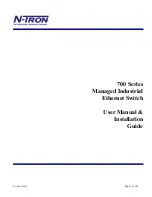
Example 3, 1D Trunk Connection to 802.1Q VLAN Network
4-10
Examples
The Green Incorporated Network Administrators want to continue to separate normal network
traffic between the Blue and Red VLANs, and create a new isolated VLAN for Green,
Incorporated users. All divisions in the facility are to have equal access to the Mail Server on the
first floor.
4.3.1
Solving the Problem
Much of the existing network configuration can remain as it was for
Example 2, VLANs Across
Multiple Switches
. However, the Forward Default VLAN Out All Ports must be set to YES on
Switch 4 and 2, and a new 1Q Trunk port must be activated and configured on Switch 2. There are
no other real changes to the network above the first floor.
Switch 4
Switch 4 is set as follows:
1.
The Forward Default VLAN Out All Ports is set to YES using the Device/VLAN Configuration
screen. This adds the Default VLAN to the Port VLAN List of every switch port and all VLANs
become members of FID 1. This allows all traffic received from the mail server via Switch 2 and
Switch 1 to be received and classified to the Default VLAN of Switch 4.
Switch 2
Switch 2 is set as follows:
1.
The Forward Default VLAN Out All Ports is set to YES using the Device/VLAN Configuration
screen. This adds the Default VLAN to the Port VLAN List of every switch port and all VLANs
become members of FID 1.
2.
The port mode of Port 4 is set using the Port Assignment screen:
•
Port 4, Port Mode: 1Q Trunk
This causes Port 4 to be set as an additional 802.1Q Trunk port, which makes its Port VLAN List
contain all VLANs, and all frames forwarded out this port are forwarded as tagged frames.
Switch 1
Switch 1 needs to be added to the network backbone to handle traffic from the Green Incorporated
network and the mail server. To accomplish this Switch 1 is configured as follows:
1.
One VLAN is added to the list of VLANs in the Device/VLAN Configuration screen. In this
example, Switch 1 is set as follows:
•
VLAN ID 4, FID 4, with a VLAN Name of Green
2.
The Forward Default VLAN Out All Ports is set to YES using the Device/VLAN Configuration
screen. This adds the Default VLAN to the Port VLAN List of every switch port and all VLANs
become members of FID 1.













































